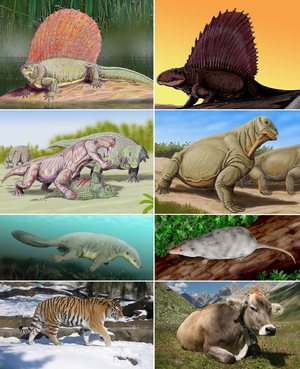Eupelycosauria
| Eupelycosauria | ||||||||||||
|---|---|---|---|---|---|---|---|---|---|---|---|---|

A selection of extinct and recent representatives of the Eupelycosauria, vou: Edaphosaurus and Dimetrodon (both early Permian , “Pelycosaurier”), Inostrancevia and Moschops (both basal therapsids of the Younger Permian), Castorocauda and Adelobasileus (both mesozoic cattle), basal mammalia recent higher mammals ) |
||||||||||||
| Temporal occurrence | ||||||||||||
| Upper carbon to recent | ||||||||||||
| 310 to 0 million years | ||||||||||||
| Locations | ||||||||||||
|
||||||||||||
| Systematics | ||||||||||||
|
||||||||||||
| Scientific name | ||||||||||||
| Eupelycosauria | ||||||||||||
| Kemp , 1982 |
The Eupelycosauria are a very inclusive taxon of the Synapsida . It includes all extinct synapsids as well as mammals with the exception of the relatively slightly diverse, late Carboniferous - early Permian Caseasauria .
It includes both “primitive” synapsids traditionally classified as “ pelycosaurs ” and all higher synapsids, but excludes the caseasauria, which are also traditionally classified as “pelycosaurs”.
definition
Originally introduced as a suborder of the order "Pelycosauria" and contrasted with the suborders Caseamorpha and Edaphosauria, they are now defined apomorphy- based as those synapsid clades whose basal representatives are an elongated, narrow supratemporal (a bone in the rear part of the dorsal roof of "primitive" land vertebrates) as well as a frontal (" frontal bone "), which has a clear proportion (at least ⅓) at the upper edge of the eye socket, so that the pre- and post-frontals are not in contact with each other.
Systematics
The Eupelycosauria form the second and orders of magnitude more diverse main line of the synapsids. Their extent and their relationships (with emphasis on the basic representatives of the clade) are shown in the cladogram below.
| Synapsida |
|
||||||||||||||||||||||||||||||||||||||||||||||||||||||||||||
|
|
Individual evidence
- ↑ Thomas S. Kemp: Mammal-like Reptiles and the Origin of Mammals. Academic Press, 1982, ISBN 0-12-404120-5 , pp. 347 f.
- ↑ Michel Laurin, Robert R. Reisz: Autapomorphies of the main clades of synapsids. Tree of Life Web Project (tolweb.org), 1997
- ^ Stuart S. Sumida: Basal Amniota - Structure and Phylogeny: Eupelycosauria. Course script, California State University San Bernardino, 2014 ( PDF 19 MB), p. 1 f.